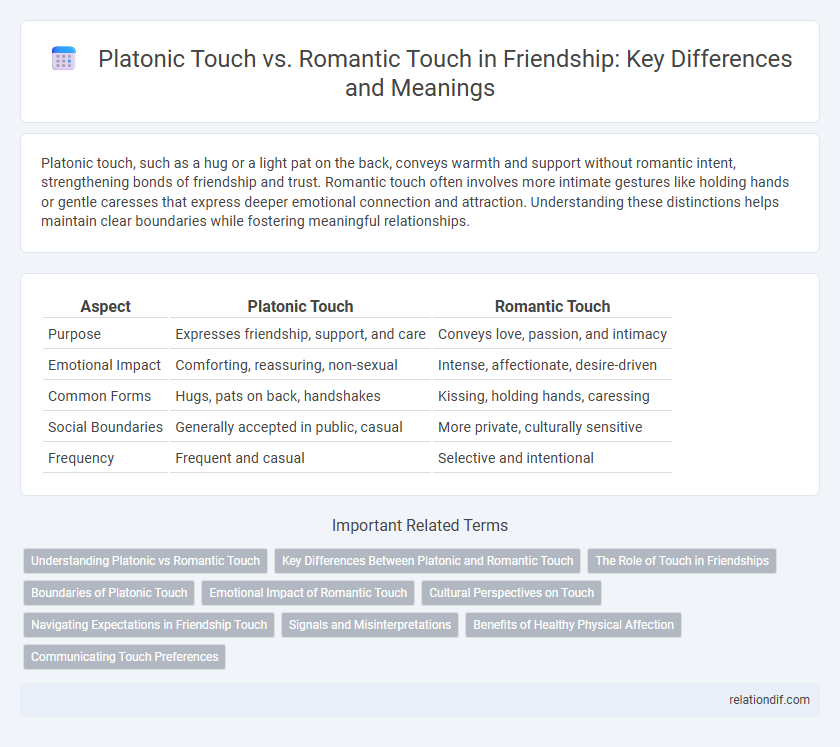Platonic touch, such as a hug or a light pat on the back, conveys warmth and support without romantic intent, strengthening bonds of friendship and trust. Romantic touch often involves more intimate gestures like holding hands or gentle caresses that express deeper emotional connection and attraction. Understanding these distinctions helps maintain clear boundaries while fostering meaningful relationships.
Table of Comparison
| Aspect | Platonic Touch | Romantic Touch |
|---|---|---|
| Purpose | Expresses friendship, support, and care | Conveys love, passion, and intimacy |
| Emotional Impact | Comforting, reassuring, non-sexual | Intense, affectionate, desire-driven |
| Common Forms | Hugs, pats on back, handshakes | Kissing, holding hands, caressing |
| Social Boundaries | Generally accepted in public, casual | More private, culturally sensitive |
| Frequency | Frequent and casual | Selective and intentional |
Understanding Platonic vs Romantic Touch
Platonic touch involves non-sexual physical contact such as hugs or handshakes that express camaraderie, trust, and support without romantic intent. Romantic touch conveys deeper emotional intimacy and attraction through gestures like holding hands, prolonged embraces, or gentle caresses. Understanding the subtle differences in intention and context behind these touches helps maintain appropriate boundaries and strengthens relationships.
Key Differences Between Platonic and Romantic Touch
Platonic touch involves casual gestures like hugs, pats, or handshakes that convey support, comfort, or camaraderie without sexual intent. Romantic touch is characterized by intimate, affectionate contact such as holding hands, caressing, or prolonged embraces that express love, desire, or deep emotional connection. Key differences include the intent behind the touch, the level of physical closeness, and the types of gestures used to communicate either friendship or romantic feelings.
The Role of Touch in Friendships
Platonic touch in friendships, such as handshakes, hugs, or pats on the back, fosters trust, emotional support, and a sense of belonging without romantic implication. This non-romantic physical contact activates the release of oxytocin, reducing stress and strengthening social bonds. Unlike romantic touch, which involves intimacy and attraction, platonic touch maintains clear boundaries while enhancing friendship quality and emotional well-being.
Boundaries of Platonic Touch
Platonic touch maintains clear boundaries focused on mutual respect and comfort, avoiding any gestures that could be misinterpreted as romantic or intimate. Common examples include friendly hugs, pats on the back, or handshakes, which reinforce trust without crossing emotional or physical limits. Understanding and respecting these boundaries is essential to preserving the integrity and safety of non-romantic relationships.
Emotional Impact of Romantic Touch
Romantic touch triggers deeper emotional responses by releasing oxytocin, dopamine, and serotonin, creating feelings of attachment, pleasure, and intimacy beyond platonic interactions. This type of touch fosters a unique bonding experience that strengthens romantic relationships through physical closeness and emotional vulnerability. Unlike platonic touch, romantic touch often elicits heightened passion and desire, intensifying the emotional connection between partners.
Cultural Perspectives on Touch
Cultural perspectives on touch significantly influence the boundaries between platonic and romantic contact, shaping social norms and personal comfort levels. In many Western cultures, platonic touch such as hugging or shoulder pats is common and socially acceptable among friends, while romantic touch is reserved for intimate relationships. Contrastingly, some Eastern and Middle Eastern cultures maintain strict physical boundaries in social interactions, where even platonic touch may be limited to same-gender friendships, reflecting deep-rooted traditions and concepts of personal space.
Navigating Expectations in Friendship Touch
Navigating expectations in friendship touch requires clear communication to differentiate between platonic and romantic intentions, as platonic touch often serves to convey support and camaraderie without romantic implications. Understanding personal boundaries and cultural norms plays a crucial role in maintaining comfort and mutual respect during physical interactions. Establishing these guidelines helps prevent misunderstandings and preserves the integrity of the friendship.
Signals and Misinterpretations
Platonic touch often conveys comfort, support, or camaraderie, with signals like light pats on the back or casual hugs that typically lack romantic intent. Romantic touch usually involves more intimate gestures such as lingering hand-holding or gentle caresses, signaling deeper emotional or physical attraction. Misinterpretations arise when context or cultural norms blur these cues, leading to confusion about the nature of the relationship and the intentions behind the touch.
Benefits of Healthy Physical Affection
Healthy physical affection, whether platonic touch or romantic touch, fosters emotional connection and reduces stress by releasing oxytocin, known as the "bonding hormone." Platonic touch, such as hugs or pats on the back, enhances trust and strengthens friendships without romantic implications, promoting psychological well-being. Romantic touch adds a layer of intimacy and passion, deepening commitment and providing emotional security within relationships.
Communicating Touch Preferences
Communicating touch preferences is essential in distinguishing platonic touch from romantic touch to maintain clear boundaries and mutual comfort. Individuals often express platonic touch through casual gestures like handshakes or light pats, whereas romantic touch may involve prolonged hugs or gentle caresses signaling deeper emotional intimacy. Clearly verbalizing and respecting these tactile boundaries fosters trust and prevents misunderstandings in friendships.
platonic touch vs romantic touch Infographic

 relationdif.com
relationdif.com